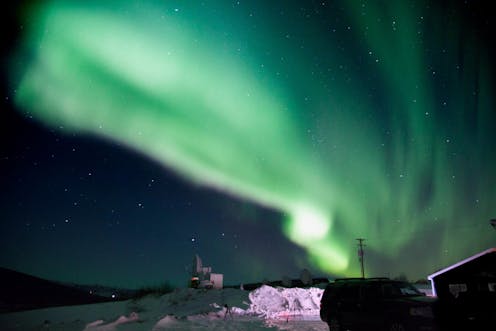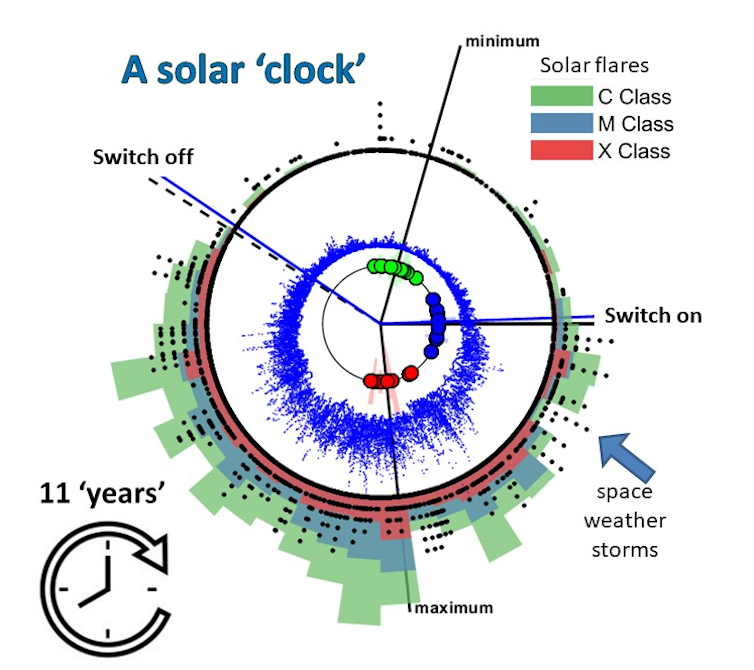
Solar cycle 25 is kicking off in style. Our sun has a cycle of activity and as it becomes more active, there will be more sightings of the northern (and southern) lights. That is what is happening this winter.
As well as emitting sunlight, our sun has an expanding atmosphere made of charged particles and magnetic fields. This high-speed solar wind blows over the Earth, but the Earth has its own magnetic field (imagine a large bar magnet with its poles roughly aligned with geographic north and south) and this can deflect the solar wind. This magnetic barrier is weakest at the poles of the “bar magnet” so that we tend to see auroral displays at high latitudes. The bigger the space weather storm, the deeper charged particles can penetrate the magnetic field of the Earth, so that during intense events, the northern lights are seen at lower latitudes.
In 2022 we have seen some spectacular auroral displays, natural light displays in the sky in more places than is usual across the UK. The UK Met office is tracking a coronal mass ejection (a sudden release of energetic charged particles and magnetic field) that left the Sun on 29 January and arrived at Earth overnight on the 1st February so we may see some nice auroral displays in northern Scotland in early February.
Northern lights are also being spotted in northern England this winter which is a tell-tale sign of increasing solar activity.
Why is this happening now?
Solar flares erupt from the surface of the sun, and these expand outwards as coronal mass ejections that carry energy in both their charged particles and magnetic fields. If a coronal mass ejection collides with the Earth, it interacts with the Earth’s magnetic field, driving a geomagnetic storm.
The Earth has a roughly dipolar magnetic field, with a tail stretched out by the solar wind, and with the poles near to the geographic north and south poles, and it is at these high latitudes that the charged particles can travel to reach the Earth’s atmosphere more easily.
Read more: Do the northern lights make sounds that you can hear?
Charged particles strike the upper atmosphere (ionosphere), causing it to glow, creating a beautiful display, the aurora borealis or northern lights. These are not just beautiful displays, these extreme space weather events can effect a wide range of systems, from power supplies, aviation, satellites, and radio communications.
Space weather
These can induce unwanted currents in any electrical power grid, causing damage and in extreme cases power cuts. The ionosphere is also disturbed, affecting communications, and further out in space, where the charged particle environment becomes more energised, and can damage satellites.
The sun has a cycle of activity, in active years, solar flares and coronal mass ejections are frequent, while in quiet years, they rarely occur. The solar cycles are on average about 11 years long but actually vary both in duration and in the level of activity. It’s possible to track the level of solar activity by counting sunspots - dark patches on the surface of the sun which correlate with likely occurrence of solar flares. The last few years have been a period of low activity and solar minimum - the minimum in the number of sunspots - was observed at the end of 2019.

We are now the rising phase of the new solar cycle of activity as the number of sunspots seen each day is steadily increasing. We can also see increasing solar flare activity. There are three categories of solar flares, measured by their X-ray emissions: X-class flares are big; they are major events that can trigger continental scale radio blackouts and city-wide power outages. M-class flares are medium-sized; they can cause brief radio blackouts that affect Earth’s polar regions. C-class flares are small with few noticeable consequences here on Earth.
On October 9, an M-class solar flare erupted sending a coronal mass ejection that hit Earth on October 12, triggering a moderate geomagnetic storm. On November 3 and 4, we saw the most intense geomagnetic storm to hit Earth since September 2017.
Since each solar cycle is unique both in duration and activity level, it is difficult to predict how active the next phase of the new solar cycle will be. Recently research mapped this irregular cycle in time onto a uniform solar cycle clock, shown in the graphic above.
We can read back from the sun clock to see where (or when) we are in the solar cycle, so as well as helping tourists to plan their Nordic holidays to see the northern lights, this graphic could also help power grid operators who need to schedule critical maintenance during periods of quiet space weather.
Professor Sandra C Chapman receives funding from STFC and AFOSR. She works for the University of Warwick, UK, and the University of Tromso, Norway.
This article was originally published on The Conversation. Read the original article.







